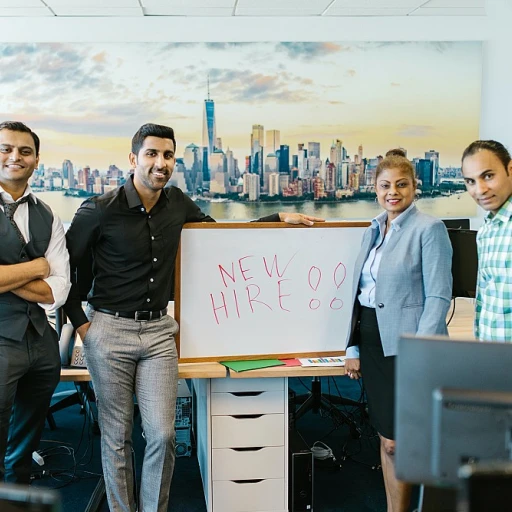
Understanding High Potential Employees
Decoding the Profile of High-Potential Employees
High-potential employees are often regarded as rising stars within organizations. These individuals consistently exhibit qualities that set them apart from their peers, making them invaluable assets to any business. Understanding what makes these employees unique is essential in fostering leadership development and promoting a productive work environment. High-potential employees exhibit a dynamic combination of skills, ambition, and leadership. They frequently show an innate ability to lead teams effectively, displaying not just technical prowess but also interpersonal competence. This group of employees is likely to possess a keen sense of emotional intelligence, enabling them to navigate complex team dynamics and build strong relationships within the company. A key aspect of recognizing these employees lies in observing their leadership style. These individuals often demonstrate a people-oriented leadership approach, prioritizing not only the achievement of goals but also the well-being and development of their team members. The ability to cultivate trust among their peers and engage employees effectively further distinguishes them in leadership roles. Moreover, high-potential employees are often proactive in seeking opportunities for development. They are not just waiting to be tapped for leadership roles; they actively prepare themselves by developing their leadership skills and knowledge. Their hunger for growth and learning signals their readiness to take on greater responsibilities. Another critical trait of high-potential employees is their ability to contribute to and sustain a positive work culture. They often demonstrate an aptitude for aligning their team's efforts with the broader organizational goals, ensuring cohesive and effective team dynamics. This coherent alignment of individual and business objectives ultimately leads to superior performance outcomes. For more in-depth insights into navigating organizational structures and resources that support high-potential employees, consider exploring the Corporate Leadership Council guide, which provides valuable information for both current and aspiring leaders.The Role of People Leadership
Effective Team Dynamics Through People Leadership
Understanding the importance of people leadership is crucial for nurturing high potential employees. At its core, people leadership revolves around cultivating an environment where team members feel valued, understood, and empowered to achieve their goals. A successful leader must possess emotional intelligence, the ability to connect with team members on a personal level to foster trust and transparency. This leadership style enhances employee engagement, resulting in a more motivated and driven team. Key Characteristics of People Leadership:- Communication: Open and transparent communication is vital for effective management. Leaders should encourage employees to share their ideas and concerns.
- Empathy: Understanding and empathizing with an employee’s perspective can make a significant difference in building a positive work environment.
- Trust-building: Establishing trust within the team ensures effective collaboration and commitment to common objectives.
- Adaptability: Leaders should be flexible, ready to adjust their approach based on the team’s dynamics and needs.
Identifying High Potential Employees
Spotting the Gems in the Rough
Identifying high potential employees is a crucial step in building a successful team structure and fostering effective leadership management. These employees are not just about showing technical prowess, but they possess a diverse range of characteristics that distinguish them from their peers. Recognizing these individuals early on is crucial for their development, helping organizations propel them into leadership roles effectively.
Here are some key indicators to identify high potential employees:
- Consistent Performance: Look for team members who consistently meet or exceed expectations. These individuals demonstrate reliability, a commitment to goals, and a strong work ethic which sets a foundation for leadership growth.
- Adaptability: High potential employees exhibit the ability to adapt to new challenges or changes in their work environment. Their adeptness in managing transitions smoothly is a valuable trait for future leaders.
- Emotional Intelligence: Leaders need to handle team dynamics with care, and those with high emotional intelligence usually excel in people leadership. They build trust and foster a culture of employee engagement, both crucial for nurturing a productive team environment.
- Cultural Fit: Aligning with the company’s culture is imperative for effective people management. Employees who embody the business values are more likely to be good influences on their peers, enhancing team cohesion.
- Thirst for Knowledge: Those who are eager to learn and seek personal development opportunities often transition smoothly into leadership roles. Their drive to expand their skills and knowledge base can set them apart.
By focusing on these attributes, business leaders and managers can more easily identify and nurture employees who demonstrate potential. It’s about creating an environment that not only recognizes these employees but also supports their journey to becoming highly effective leaders. Integrating support systems that align with these characteristics can greatly enhance leadership development within organizations.
Developing Leadership Skills
Building Essential Skills for Leadership
Developing leadership skills in high potential employees is a critical step in preparing them for future roles within your organization. These individuals possess the capability to drive change and inspire their teams, but honing their abilities is essential for effective people leadership.
Fostering Emotional Intelligence
Emotional intelligence is a cornerstone of effective leadership. High potential employees must learn to navigate complex team dynamics and understand the emotional cues of their team members. This skill enhances their ability to build trust and foster a positive work environment, crucial for achieving team goals.
Enhancing Decision-Making Abilities
Leaders often face challenging decisions that impact the entire business. Training high potential employees in decision-making processes helps them weigh options, consider the implications of their choices, and make informed decisions. This development is vital for their growth as future leaders.
Adapting Leadership Styles
Effective leaders are versatile in their approach. High potential employees should be encouraged to explore different leadership styles, from people-oriented leadership to more task-focused approaches. This adaptability ensures they can lead diverse teams effectively, regardless of the work environment or business challenges.
Encouraging Continuous Learning
Leadership development is an ongoing journey. Encouraging high potential employees to engage in continuous learning opportunities, such as workshops, seminars, and mentorship programs, keeps their skills sharp and their perspectives fresh. This commitment to growth is essential for sustaining their effectiveness as leaders.
Building a Culture of Feedback and Engagement
A culture that values feedback and employee engagement is crucial for leadership development. High potential employees should be encouraged to seek feedback from peers and leaders, fostering an environment of open communication and mutual respect. This culture supports their growth and prepares them for leadership roles.
Challenges in People Leadership
Overcoming Leadership Hurdles
In the journey to becoming an effective leader, high potential employees often encounter several challenges that must be navigated carefully. One of the primary obstacles is developing a management style that resonates with diverse teams while fostering an inclusive work environment. A good leader must understand their team members' unique needs, strengths, and weaknesses to build a cohesive and productive team.
Another challenge is maintaining employee engagement, which requires a people-oriented leadership approach. When leaders genuinely connect with their employees, they create a culture of trust and open communication, essential for effective people management. Emotional intelligence plays a crucial role in this process, as it allows leaders to empathize with their team and adapt their leadership style to fit the dynamic needs of their employees.
Time management and prioritizing tasks can also pose significant challenges for emerging leaders. Balancing day-to-day responsibilities while focusing on long-term business goals requires skillful decision making and strategic planning. This is where thought leadership becomes invaluable, offering insights and strategies to help leaders navigate complex situations and maintain a clear vision for their team.
Leadership success also hinges on continual development. Investing time in refining leadership skills through training and professional development opportunities ensures that high potential employees are well-equipped to meet these challenges. This adaptive approach prepares them for the evolving demands of global leadership, where effective leaders are those who can lead with vision, confidence, and adaptability.
The Future of Leadership Development
Shaping the Leadership Horizon
The evolving landscape of leadership development demands a shift to new paradigms. With a stronger focus on people leadership, it becomes imperative to prepare high potential employees to adapt and thrive. But what does the future hold for leadership development?- Emphasis on Emotional Intelligence: The future will see an increased emphasis on emotional intelligence as a cornerstone of effective people management. Understanding and empathizing with team members not only builds trust but also enhances team dynamics.
- Global Leadership: In an increasingly globalized business environment, future leaders must possess the skills to navigate diverse work cultures. The ability to think globally and act locally will define successful leaders and enable them to make informed decisions across geographies.
- Integration of Technology: As technology continues to evolve, it will redefine how leaders interact with their teams. This encompasses virtual team management, leveraging data for informed decision-making, and enhancing employee engagement.
- Continuous Learning: With rapidly changing business landscapes, ongoing leadership development will be indispensable. Encouraging employees to continuously hone their leadership skills will foster a resilient, adaptable workforce.












